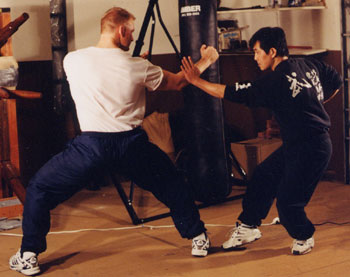
-KUM-
Kum - a pressing or a slapping deflection. Similar to a parry in western boxing this element is designed to deflect incoming strikes from various angles. It is also used to pin or immobilize an opponent's limbs from further counter attack.

-NA-
Na - is introduced to the student with the chuen na technique. Chuen na itself is taught in two parts - chuen (shooting arm bridge) and na (to seize). As grabbing (or seizing) an opponent's limb will in most cases limit our own attack to the use of only one arm (as one is occupied with the "seizing" of the opponent's limb), we choose to place greater emphasis on the chuen portion of this element. As a chuen, the arm is used to spear through, intercept, and redirect an opponent's attacks. A more piercing interception will cut into the opponent's center of gravity, enabling the Choy Lay Fut practitioner to uproot the opponent.
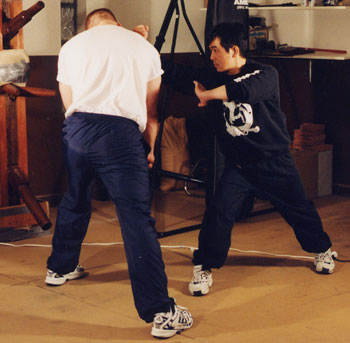
-GWA-
Gwa - a downward backfist. A powerful swinging technique frequently used in combination with other elements to strike heavily into the opponent. When used as a "destruction" (incapacitating the opponent's striking limb during its attack), the force of the blow will often leave the opponent off balanced and open for a follow-up strike. A compacted version of this element is often executed in conjunction with a chop chue (a fore knuckle strike) to the opponent's middle-gate (the abdomen). When the middle-gate is struck with a chop chue, the upper-gate (the head) opens for an opportune gwa chue.

-SAU-
Sau - an inward sweeping punch. A powerful signature strike of the Choy Lay Fut method, the sau chue frequently becomes a finishing blow when accurately used. The structure of this strike is designed to both impact and rake into the surface the intended target. The power from this strike comes from the downward angular sweeping motion generated by the waist and shoulders of the practitioner upon a solid yet flexible stance. However, like many of Choy Lay Fut's extended strikes, the execution of this element will leave the practitioner open for counterattacks if not preceded or followed by additional techniques. This is why aggressive continuation and flowing combinations are stressed in the practice of Choy Lay Fut.
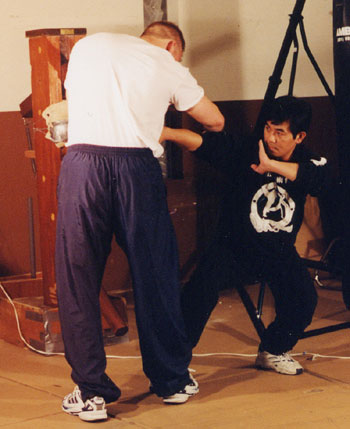
-CHOP-
Chop - fore-knuckle strike Often used in a fashion similar to a jab in western boxing, the chop chue is frequently used to force open different gates (targets) on the opponent to be struck by follow-up techniques. There are two main variations of this element, the yerng (yang) chop and the yum (yin) chop. The yerng chop originates from the hip and is executed at a slightly upward path and angle into the opponent's solar plexus and ribs. The yum chop is mostly executed towards the same targets, however the yum chop is executed from the ear-level of the practitioner with a drilling (twisting) motion that travels in a downward path and angle. The two variations are often used in conjunction with each other to continuously strike at the same target.

-POW-
Pow - an upward power shot. A pow chue derives its power from the momentum of a circular upward swing. This strike is frequently executed in a continuous fashion toward an opponent's center, driving them off balance and forcing a backward retreat. This strike can be executed while either facing the opponent square or to the side.
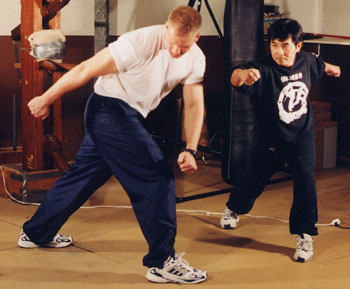
-KUP-
Kup - a sweeping fist slap. A kup chue is executed similarly to the sau chue except taking a slightly more horizontal path. The striking surface of this element are the inside fore-knuckles of the fist, and when executed, this technique resembles a "slap" from a closed fist. The structure of this strike is designed to smash and rake into the flesh of the opponent.
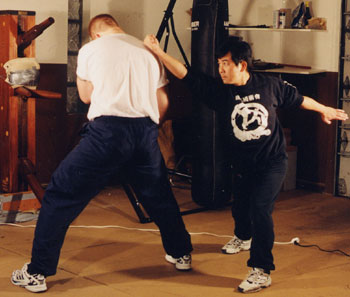
-BIU-
Biu - an outward shooting forearm strike. Using both the inner forearm and the fist as the striking surface, this element is frequently used as a follow-up to other elements and strikes. This attack takes the striking surfaces of the inner forearm and fist in a swinging outward motion toward the intended target. An extended version of this element can be used to uproot an opponent, while a compacted variation can be used as a quick and penetrating strike to an opponent's center.

-DING-
Ding - elbow strike. Though this element is technically a thrusting elbow strike, any attack utilizing the major joints of the human body can be categorized as a ding (i.e. a knee strike, a shoulder butt, etc.). The angle and path of this element can vary. By design, this element is executed only with a compacted structure.

-JONG-
Jong - a small upward power shot (uppercut). While a pow chue gains its power from the momentum of a circular upward swing, the jong derives its power from a direct upward thrusting motion perpendicular from the ground. This element is often executed while fist is directly below the intended target.